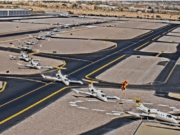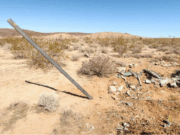
The following information provides an awareness of problems that might be avoided in the future. The information is based on final reports by official investigative authorities on aircraft accidents and incidents.
 Jets
Jets
Unheeded Warnings
Cessna Citation CJ4. Destroyed. Six fatalities.
Marginal visual meteorological conditions (VMC) prevailed at Cleveland’s Burke Lakefront Airport the night of Dec. 29, 2016. Visibility was 9 mi (14 km), and there were scattered clouds at 1,500 ft and a broken ceiling at 2,300 ft. The surface winds were from 260 degrees at 22 kt, gusting to 31 kt, as the CJ4 pilot prepared for takeoff from Runway 24R at 2255 local time.
The airport traffic controller instructed the pilot to turn right to a heading of 330 degrees and to maintain 2,000 ft after takeoff. The pilot correctly read back the instructions, which would take the light jet out over Lake Erie during the departure.
The airplane entered instrument meteorological conditions (IMC) shortly after lifting off from the runway and entering a steep climbing right turn, according to the report by the U.S. National Transportation Safety Board (NTSB). The airplane’s climb rate was more than 6,000 fpm when cockpit aural alerts sounded before and after the CJ4 climbed through the assigned initial altitude of 2,000 ft.
The right bank angle increased to about 62 degrees as the airplane turned through the assigned heading of 330 degrees. At the same time, the CJ’s pitch attitude suddenly decreased to about 15 degrees-nose down. “During the subsequent descent, the airspeed and descent rate reached about 300 knots and 6,000 fpm, respectively,” the report said. “The enhanced ground-proximity warning system (EGPWS) provided both ‘bank angle’ and ‘sink rate’ alerts to the pilot, followed by seven ‘pull up’ warnings.”
The CJ4 was destroyed when it struck the surface of Lake Erie about two minutes after takeoff. The pilot and his five passengers were killed. “A post-accident examination of the recovered wreckage did not reveal any anomalies consistent with a pre-impact failure or malfunction,” the report said.
Investigators determined that the pilot had attempted unsuccessfully to engage the autopilot after takeoff. He had acquired the airplane a few weeks previously, and its primary flight displays and flight control system panels differed somewhat from those in the smaller Citation Mustang that he had flown previously. The attitude indicator displays were slightly different in the CJ4, and the autopilot engagement pushbuttons and annunciators were in different locations. The report said that the differences likely led to “mode confusion,” which caused the pilot to believe, incorrectly, that the autopilot was engaged and to become confused about the airplane’s flight path.
Moreover, “the pilot likely experienced some level of spatial disorientation due to the dark night lighting conditions, the lack of visual references over the lake and the encounter with [IMC],” the report said. “It is possible that once the pilot became disoriented, the negative learning transfer due to the differences between the [CJ4 and the Mustang] may have hindered his ability to properly apply corrective control inputs.”
The NTSB concluded that “controlled flight into terrain due to pilot spatial disorientation” was the probable cause of the accident. The board also determined that fatigue was among the contributing factors. “Available information indicated that the pilot had been awake for nearly 17 hours at the time of the accident,” the report said. “As a result, the pilot was likely fatigued, which hindered his ability to manage the high workload environment, maintain an effective instrument scan, provide prompt and accurate control inputs, and respond to multiple bank angle and descent rate warnings.”
Lightning Zaps Displays
Boeing 787-8. Minor damage. No injuries.
The 787 was climbing through 4,000 ft while departing from London for a scheduled passenger flight to Houston the afternoon of Oct. 10, 2014, when a lightning strike disabled three of the five cockpit flight displays. The captain said that the aircraft was flying along the edge of an area of moderate rain showers when a static discharge caused both of his flight displays and the outboard display on the copilot’s panel to fail.
The NTSB report noted that there were no procedures related to a partial loss of flight displays. “After the [flight] crew elected to follow the ‘Loss of All Displays’ checklist, none of the affected displays recovered to an operational state,” the report said.
The crew declared an emergency, dumped fuel, returned to London Heathrow Airport and landed the 787 without further incident. An examination of the aircraft revealed minor lightning strike damage on the left side of the nose.
“All of the displays did recover normal operation after [maintenance personnel performed] a power cycle to the displays while the aircraft was on the ground,” the report said. “No procedures existed for a power reset of the displays while in flight, which most likely would have resulted in a restoration of the displays.”
Upset at 41,000 Feet
Dassault Falcon 2000. No damage. No injuries.
En route on a charter flight from Delhi, India, to Hubli the morning of April 26, 2018, the Falcon was cruising at Flight Level (FL) 410 (approximately 41,000 ft) when the yaw damper failed and the autopilot disengaged. “Both the pilots got busy in isolating the autopilot failure and did not realize that the aircraft had gone into a right bank [until] a bank angle warning got activated,” said the report by India’s Directorate General of Civil Aviation.
The bank angle had reached 65 degrees when the pilot-in-command (PIC) took manual control of the aircraft, recovered from the upset and initiated a climb back to FL 410. The aircraft had descended 735 ft during the 15-second upset.
The flight crew attempted unsuccessfully to re-engage the autopilot. They reported the situation to air traffic control (ATC) and advised that, due to the autopilot failure, they no longer complied with reduced vertical separation minimum (RVSM) requirements. ATC issued descent clearances that eventually brought the Falcon below RVSM airspace.
The crew continued flying the aircraft manually and landed without further incident at the Hubli airport about 30 minutes after the upset occurred. None of the five passengers, the flight attendant, the maintenance technician or the two pilots was injured, and the Falcon was not damaged.
An inspection of the automatic flight control system at Hubli revealed no discrepancies, and the crew was authorized to ferry the Falcon back to Delhi. During the flight, the yaw damper and autopilot functioned normally.
“During detailed inspections at Delhi, the fault [that occurred during the flight to Hubli] could not be reproduced on the ground; however, the [no. 2 flight control computer] was suspected [of] intermittent function and hence was removed and sent to the manufacturer for investigation,” the report said. The manufacturer found that an intermittent fault in the flight control computer had caused the yaw damper to fail and the autopilot to disengage.
 Turboprops
Turboprops
Overweight Overrun
Beech King Air 100. Substantial damage. No injuries.
The pilot told investigators he realized that the King Air exceeded its maximum takeoff weight with full fuel, nine passengers and their baggage. However, there was no record that he calculated the airplane’s actual takeoff weight and balance, or determined its takeoff performance, the NTSB report said.
The airplane later was found to be 623 lb (283 kg) over maximum weight when the pilot initiated a takeoff from the 5,500-ft (1,676-m) runway at Jeffersonville, Indiana, U.S., the afternoon of Oct. 30, 2016.
A commercial pilot occupied the right front seat and was designated as “safety pilot” for the private flight, but he had received no training in King Airs and was not familiar with the airplane’s systems and operating procedures. The pilot advised him that the takeoff would be “heavy.”
The pilot said that he applied full power before releasing the brakes for takeoff. “However, he did not confirm the power settings that he applied when he advanced the throttles,” the report said. He perceived that the airplane was not accelerating normally during the takeoff roll and noticed that the indicated airspeed was only 80 kt halfway down the runway. Nevertheless, he continued the takeoff.
“He stated that he heard the other pilot say ‘redline,’ so he decreased the power,” the report said. “At this point, the airplane had reached the last third of the runway, and the pilot pulled back on the control yoke to lift the airplane off the runway, but the stall warning sounded. … Neither the pilot nor the [safety] pilot called out for an aborted takeoff, and when they recognized the need to abort the takeoff, it was too late to avoid a runway excursion.”
The pilot said that he lowered the nose but did not “get on” the brakes or place the propellers in reverse. The King Air ran off the departure end of the runway and struck instrument landing system antennas. The landing gear collapsed, and the propellers struck the ground before the airplane slid to a stop 680 ft (207 m) from the runway. The damage was substantial, but none of the 10 occupants was injured.
Stall on Turn to Final
Socata TBM 700N. Substantial damage. One serious injury, one minor injury.
Weather conditions at Fairoaks Airport in Surrey, England, the morning of Oct. 15, 2016, included 4,000 m (2 1/2 mi) visibility in mist, a few clouds at 4,000 ft and surface winds from 240 degrees at 3 kt. The pilot told his passenger that he would attempt a visual approach to Runway 24 at Fairoaks and divert to Farnborough Airport if he was unable to land the TBM.
“The pilot identified the airfield visually, although there was low-lying mist in the area,” said the report by the U.K. Air Accidents Investigation Branch. “In order to maintain visual contact with the landing area, he joined the circuit and flew a downwind leg that was closer to the runway than usual.”
During the turn from base to final, the aircraft flew through the extended runway centerline. The pilot tightened the left turn in an attempt to correct the flight path. “The aircraft then rolled quickly in the opposite direction, and he again applied a correction,” the report said. “The pilot’s next recollection was of being in a right bank and seeing only sky ahead.”
The pilot was able to bring the TBM back to a nearly wings-level attitude but saw that the aircraft was descending rapidly. “He responded by pulling back hard on the control column but was unable to prevent the aircraft [from] striking the ground,” the report said.
The aircraft struck the ground in a flat attitude, slid about 85 m (279 ft) and came to a stop against trees. The TBM was substantially damaged. A fuel tank ruptured, but there was no fire. The pilot was seriously injured, and his passenger sustained minor injuries.
“The available evidence indicates that the aircraft stalled during the turn onto the final approach,” the report said. “Recovery actions … appear to have been partially successful, but there was evidently insufficient height in which to effect a full recovery.”
Takeoff Warnings Ignored
Embraer 120ER. Sixteen fatalities, four serious injuries.
While preparing for a charter flight from Lagos, Nigeria, to Akure the morning of Oct. 3, 2013, the flight crew discussed the Brasilia’s airworthiness status and expressed concern about its suitability for the flight, said the report by the Nigerian Accident Investigation Bureau (AIB).
After starting the engines, the pilots noticed that the left engine torque indication was stuck at 76 percent (the normal indication with power at idle is 22 percent). Although the false indication persisted after a test of the electronic engine controls, the crew decided to proceed with the flight.
Torque indications are the primary references when setting power, but the crew set power with reference to engine temperature indications, a “nonstandard” and “inappropriate” procedure, the report said. The report also said there were indications that, likely due to previous problems with the flaps, the crew intentionally initiated the takeoff with the flaps retracted, an unauthorized procedure.
During the takeoff, the crew received aural warnings that the flaps were not in the takeoff configuration and that the propeller autofeathering system was not available. The report said that either warning was grounds to reject the takeoff. Moreover, the propeller rpm indications were 100 percent for the left engine but only 55 percent for the right engine. This, too, called for a rejected takeoff, according to the report.
The warnings and the aircraft’s abnormally slow acceleration prompted the first officer, the pilot monitoring, to ask the captain if the takeoff should be rejected. “No, let’s continue,” the captain said.
As the aircraft neared the end of the runway, the captain initiated rotation before V1 was attained. Shortly after the Brasilia lifted off the runway, the first officer said, “Aircraft not climbing. Don’t stall.” An aural stall warning then sounded, and the first officer advised the captain to lower the nose. The captain told the first officer to apply full power about the same time the aircraft stalled.
“The aircraft attained a maximum altitude of 118 feet, drifted to the right and impacted the ground in a nose-down attitude with a steep roll to the right,” the report said. The Brasilia was destroyed by the impact and fire. Eleven passengers and five crewmembers were killed, and two passengers and two crewmembers were seriously injured.
The AIB determined that the causal factors of the accident were “the decision of the crew to continue the takeoff despite the abnormal no. 2 propeller indication [and a] low-altitude stall as a result of low thrust at the start of the roll for takeoff from the no. 2 engine, caused by an undetermined malfunction of the propeller control unit.”
 Piston Airplanes
Piston Airplanes
Engine Starved for Fuel
Piper Chieftain. Substantial damage. One fatality, one minor injury.
The main fuel bladder in the Chieftain’s right wing had been replaced at an undetermined time before the accident, but the flapper valve, which prevents unporting when the fuel level in the tank is low, had not been reinstalled. The maintenance error was among the probable causes of the airplane’s crash in Weston, Florida, the afternoon of Oct. 26, 2015, according to the NTSB report.
The pilot was conducting a business flight in VMC with two passengers from Jacksonville to Fort Lauderdale. The airplane was about 15 nm (28 km) from the destination when ATC told the pilot to turn right for sequencing for a visual approach. “During the right turn, the fuel in the right main fuel tank moved outboard [away from the fuel port], which resulted in fuel starvation to the right engine,” the report said.
After the right engine lost power, the pilot feathered the wrong (left) propeller to configure the airplane for single-engine flight. Unable to maintain altitude, the pilot told ATC that he might have to land the airplane straight ahead on a highway; however, the forced landing occurred in a nearby marsh. The pilot was killed, one passenger was seriously injured, and the other passenger sustained minor injuries. The Chieftain was substantially damaged.
In addition to the maintenance error that resulted in the omission of the flapper valve in the right fuel tank, the pilot’s feathering of the incorrect propeller was a probable cause of the accident, according to the NTSB.
“Contributing to the accident was the pilot’s impairment due to alcohol consumption,” the report said. “Toxicology testing of the pilot revealed that his blood alcohol level during the flight was likely between 0.077 gm/dl [grams per deciliter] and 0.177 gm/dl, which is above the level generally considered impairing.”
Gear Retracted Too Soon
Piper Aerostar 600A. Substantial damage. No injuries.
The pilot told investigators that after lifting off the runway at Tallahassee, Florida, U.S., the afternoon of Oct. 27, 2017, he “reached down to retract the gear” and “glanced down” to ensure that he had his hand on the correct lever. He admitted that he retracted the landing gear prematurely and likely relaxed back-pressure on the control yoke when he leaned forward to grab the landing gear lever, the NTSB report said.
When he looked back outside, he saw that the Aerostar was “near the runway” and “pulled back hard on the yoke.” The propellers on both engines struck the runway, and the Aerostar skidded off the pavement onto a grassy area. Damage was substantial, but the pilot and his two passengers were not injured.
 Helicopters
Helicopters
Main Rotor Separates
Fairchild Hiller 1100. Destroyed. Two fatalities.
VMC prevailed when the pilot took off with a passenger for a local flight from Anoka County–Blaine Airport near Minneapolis, Minnesota, U.S., the afternoon of Oct. 6, 2016. It was his third flight of the day, after having not flown the helicopter for nearly a year.
Several witnesses who saw the FH-1100 in flight said that they heard a “clunk” or a “pop” and saw the helicopter rock back and forth before entering a steep, spiraling descent while shedding parts. “One witness saw the main rotor blades ‘seize’ then ‘snap off,’ followed by the tail rotor departing the helicopter,” the NTSB report said.
The helicopter was destroyed when it struck terrain near Lino Lakes. The pilot and his passenger were killed.
The NTSB determined that the accident was caused by mast bumping. “Mast bumping can occur in low-acceleration-of-gravity (G) flight conditions, causing the rotor blade to exceed its flapping limits and resulting in the main rotor hub bumping into the rotor shaft,” the report said. “This often results in structural failure of the rotor shaft and a subsequent separation of the main rotor.”
“The pilot’s control inputs are unknown, and the initiating event for the mast bumping could not be determined,” the report said. “It is possible that he made a large, abrupt flight control input that resulted in a low-G flight condition and led to the observed mast bumping.”
Tail Rotor Effectiveness Lost
Eurocopter AS350-B3. Substantial damage. No injuries.
The AS350 was being flown in formation with two Robinson R22s on a private holiday trip from Pilanesburg, South Africa, to Jack’s Camp, Botswana, the morning of Oct. 31, 2012. The pilots made an en route stop at Francistown, Botswana, to refuel and to clear customs and immigration.
Shortly after the AS350 pilot took off closely behind the R22s, the helicopter entered a spin and crashed near a fueling bay. The main and tail rotor blades, tail boom and fuselage were substantially damaged on impact, but the pilot and his passenger were not injured.
The Directorate of Accident Investigation for Botswana determined that the probable causes of the accident were “the prevailing wind that could have caused loss of tail rotor effectiveness,” an “encounter with wake turbulence from [the] departing helicopters” and “the pilot’s lack of sufficient experience on the helicopter.”
The report said that the pilot was conducting his first unsupervised flight as PIC of a turbine helicopter. He had received his AS350 type rating and a renewal of his private pilot license the day before the accident.
| Date | Location | Aircraft Type | Aircraft Damage | Injuries |
|---|---|---|---|---|
|
NA = not available This information, gathered from various government and media sources, is subject to change as the investigations of the accidents and incidents are completed. |
||||
| Aug. 1 | Kananaskis, Alberta, Canada | Piper Navajo | destroyed | 2 fatal |
| The pilot and a technician were conducting a survey flight when the Navajo struck a mountain. | ||||
| Aug. 4 | Glarus, Switzerland | Junkers Ju-52 | destroyed | 20 fatal |
| The Ju-52 was on a charter flight from Locarno Air Base to Dübendorf Air Base when it entered a left turn in a mountain basin and spiraled to the ground at 8,334 ft. | ||||
| Aug. 4 | Talkeetna, Alaska, U.S. | de Havilland DHC-2 | substantial | 5 fatal |
| Visual meteorological conditions prevailed when the Beaver struck a mountain ridge at 10,920 ft during a sightseeing flight. | ||||
| Aug. 5 | Santa Ana, California, U.S. | Cessna 414 | substantial | 5 fatal |
| The pilot was turning left to enter the landing pattern at John Wayne–Orange County Airport when the 414 entered a rapid descent and crashed in a shopping mall parking lot. | ||||
| Aug. 7 | Lalgarh, India | Cessna 208B | substantial | 9 none |
| The Caravan veered off the runway on landing and struck a wall. | ||||
| Aug. 7 | San Luis Potosí, Mexico | Dassault Falcon 20D | substantial | 2 minor |
| The Falcon developed engine problems during a night cargo flight from Querétaro, Mexico, to Laredo, Texas, U.S. The flight crew diverted to San Luis Potosí but had to conduct a forced landing in a field about 2 mi (1 km) from the airport. The aircraft struck a small building, killing a donkey, during the landing. | ||||
| Aug. 8 | Lewiston, Idaho, U.S. | Cessna T337 | substantial | 2 none |
| The Skymaster was returning from a firefighting support flight when the landing gear failed to extend. The pilot made several unsuccessful attempts to extend the landing gear before landing the airplane with the gear retracted. | ||||
| Aug. 9 | Istanbul | Boeing 787-8 | substantial | none |
| The 787 was being taxied from the gate when its right wing tip struck the tail section of a 777. | ||||
| Aug. 10 | Seattle, Washington, U.S. | Bombardier Q400 | destroyed | 1 fatal |
| An airline ground service agent, who was not a licensed pilot, stole the Q400 and conducted several aerobatic maneuvers over Puget Sound before the airplane struck terrain on Ketron Island. | ||||
| Aug. 11 | Abbotsford, British Columbia, Canada | de Havilland Dragon Rapide | NA | 2 serious, 3 minor |
| One passenger and the pilot were seriously injured, and three other passengers sustained minor injuries when the vintage aircraft banked right on initial climb and struck terrain while departing for a sightseeing flight during an air show. | ||||
| Aug. 11 | Oksibil, Papua, Indonesia | Pacific Aerospace 750XL | destroyed | 7 fatal, 1 serious |
| The single-engine airplane struck trees and crashed during a scheduled passenger flight. One passenger survived. | ||||
| Aug. 13 | Payson, Utah, U.S. | Cessna CitationJet | destroyed | 1 fatal |
| The pilot intentionally crashed the CitationJet that he flew for a company in the front yard of his house the night after being charged by police with domestic assault. A woman and a child inside the house were not hurt. | ||||
| Aug. 15 | Rome | Boeing 777-300 | substantial | none |
| The 777 was being pushed back from a remote stand at Fiumicino Airport when its right wing struck a light pole. | ||||
| Aug. 16 | Manila, Philippines | Boeing 737-800 | substantial | 165 none |
| The flight crew rejected their first approach to Nino Aquino International Airport and held for about 15 minutes before attempting another landing in heavy rain associated with a thunderstorm. The left engine and the landing gear separated when the 737 veered off the left side of the runway after touchdown. | ||||
| Aug. 19 | Gera, Germany | Antonov 2T | substantial | none |
| The parachutists and the pilot evacuated the An-2 biplane safely when exhaust flames ignited the right wings during engine start. | ||||
| Aug. 21 | Limoges, France | Piper Navajo | destroyed | 2 serious |
| The pilot and a technician were returning from an aerial photography flight when both engines lost power due to fuel exhaustion. The Navajo struck trees and crashed in a field during the forced landing 5 km (3 nm) from the airport. | ||||
| Aug. 22 | Taichung, Taiwan | ATR 72-600 | NA | 74 none |
| A thunderstorm was over the airport when the ATR struck a runway edge light while landing. | ||||
| Aug. 26 | Pieri, South Sudan | Cessna 208B | substantial | NA |
| No injuries were reported when the Caravan struck a cow on takeoff. The aircraft’s nose was crushed, and the nose landing gear collapsed during the collision. | ||||
| Aug. 28 | Shenzhen, China | Airbus A320-214 | substantial | NA |
| The flight crew rejected a landing at Macau after a nose landing gear bogey separated on touchdown. No injuries were reported among the 157 passengers and nine crewmembers when the pilots subsequently landed the A320 at Shenzhen. | ||||
| Aug. 30 | Mojo, Ethiopia | de Havilland DHC-6 | destroyed | 18 fatal |
| The flight crew was conducting a charter flight for the Ethiopian army from Dire Dawa to Harar Meda Air Base when the Twin Otter struck terrain about 17 km (9 nm) from the destination. | ||||
| Aug. 30 | Destin, Florida, U.S. | Beech Duke | destroyed | 4 fatal |
| The Duke struck treetops on approach and crashed in a wooded area. | ||||


